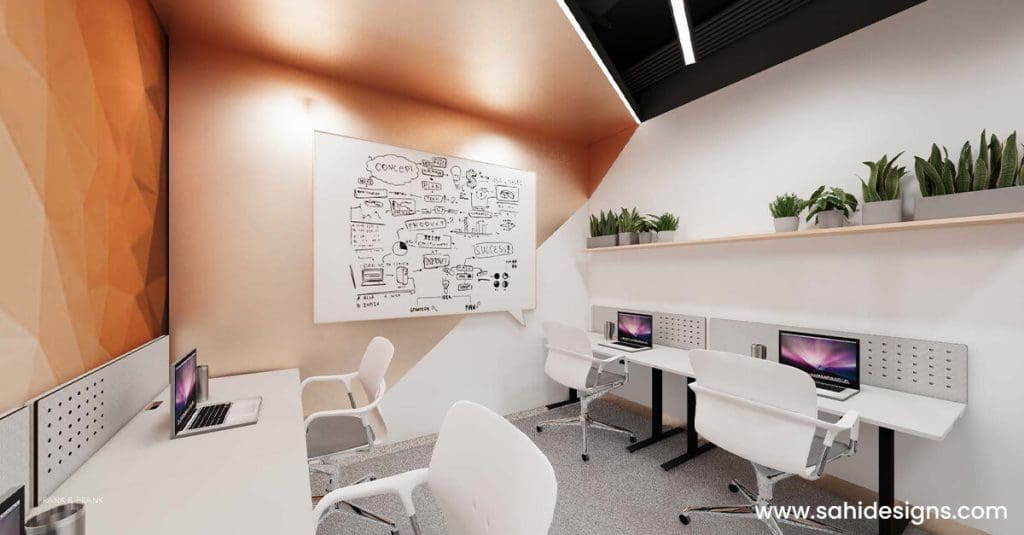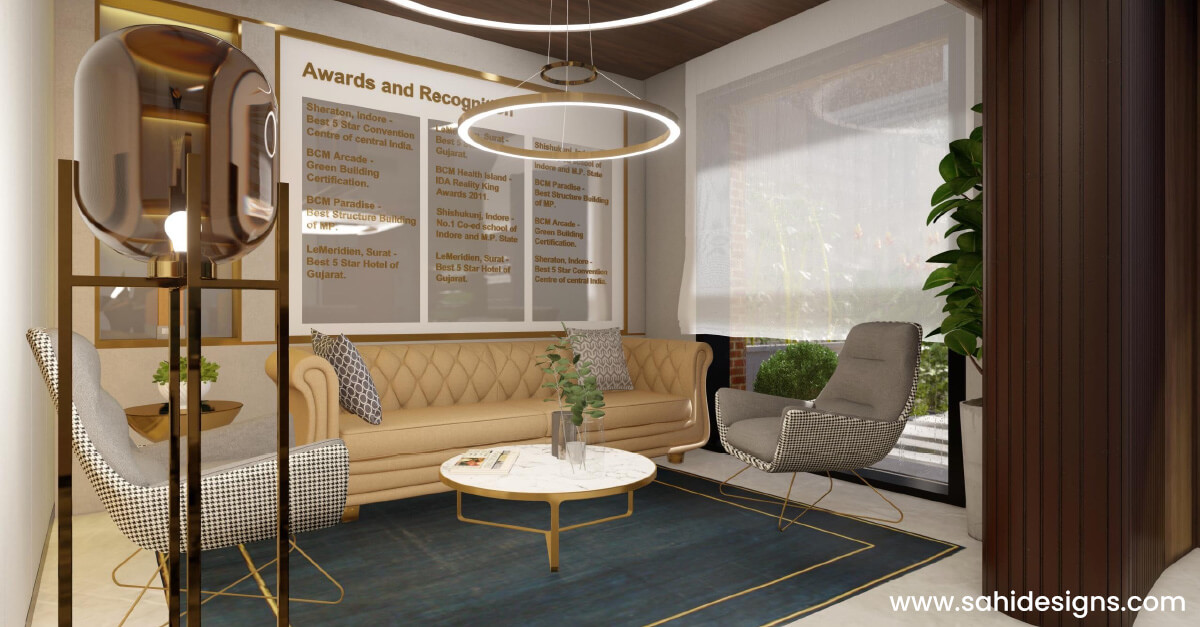Nowadays, every corporate office strives to create a welcoming, spacious, and functional workplace for its employees and clientele. Whether you’re building your workspace from scratch or revamping it, is displaying the brand logo at the office entrance, designing plush furnishings, and offering high-end amenities sufficient? Every other business adds these standard and ordinary elements to their offices.
However, if you want your office to stand out, you need to add the “extra” elements of uniqueness, creativity, and brand personalisation. Ask yourself, “What do I want my employees, customers and business partners to feel when they enter my office?” If your answer is to create a memorable experience that expresses your brand’s identity, we at Sahi Designs can assist with our innovative and customised approach. Let’s find out how!
Brand Identity Beyond Logo
Think of any business. What are the first details you associate with it? Probably the company name, logo, taglines, website, and social media. Yes, these aspects are essential for building a brand. However, relying only on your company’s intangible assets is an incomplete branding and marketing strategy as it will fail to evoke emotions, reactions and connection with your ideal prospects.
Conversely, a cohesive brand identity is a blend of visual and experiential factors that give people an idea about your brand’s personality and what your business stands for.
Businesses often overlook the design of their premises, treating it as nothing more than walls and flooring. Whether you agree or not, every location where people interact with your brand impacts them. So, if the physical environment of your workspace is designed with little or no consideration of your brand personality, you are losing the opportunity to create experiences.
Expressing your brand identity is more than focusing on aesthetics, placing your logo on every desk, or adding furniture that matches your brand colours. Instead, interior branding is about designing a space synonymous with your brand – a corporate headquarters that is your brand’s visual voice.
So, the next time someone walks through the door, you can use interior design as a branding tool to shape their perception of your brand.
For instance, Google’s offices offer the most charismatic ambience that is talked about globally. Instead of designing simple table-chair offices, Google follows a rather unconventional workplace design style. You may find nap pods, revolving bookcases that lead to other departments, climbing walls, slides, basketball courts, and more innovative design concepts at Google.
The offices may look “cool,” but the design theme is based on Google’s vision to represent its brand’s work environment as the “happiest and most productive place in the world.” Through a “casual collision interior” and playful colour selection, Google wants to promote collaborative work between employees, which leads to creativity and production.
Why Translating Brand Identity to Interior Matters?
1.Consistency: Consistency in interior design means aligning physical spaces with the brand’s values and identity. The interior design, atmosphere, and experiences must reflect the same principles and characteristics as the brand’s other touchpoints, such as the logo, colour scheme, website, and advertisement. Ensuring consistency builds trust, loyalty and recognition among employees and outsiders.

2. Visual Communication: Your office space can effectively describe your business values and ethos through design. For example, a business with innovation and simplicity as its brand values could depict the same through modern furniture, sleek glass doors, neutral colour arrangement and clean lines that evoke sophistication.
3. Impression: Whenever an outsider, such as a potential client or employee, visits your office, they interact with your physical space first. The positive experience and cohesive brand identity form a lasting impression.
4. Distinctive: Your business differentiates itself from competitors with a creative and distinct brand interior. It receives recognition for work ethics, USPs, progressive work environment, and brand individuality.

5. Boosts Employee Morale: A unified corporate office provides a satisfactory, warm, and productive setting for employees to learn and grow comfortably. It improves employee performance, reduces employee turnover, and attracts fresh talent.
How to Merge Brand Identity with Interior Design?

1.Define Your Brand Values: You must know your brand’s values before building robust interior branding. Why? Brand values form the crux of your office’s interior design and serve as guiding principles. They will help you define your business, establish a sense of purpose, and direct your design layout. They can also help you make sound strategic decisions that save time and resources. Additionally, identifying brand values differentiates you from competitors and attracts like-minded customers.
How can you define your brand values?
- Outline the purpose and mission of your business.
- Outline your target audience and clients.
- Outline your future goals and plans.
2.Establish a Visual Identity: A visual brand identity means how you want to represent your brand visually and communicate what it stands for. A brand value defines the fundamental beliefs of the business, whereas the visual identity is the characteristics and emotions you want to convey about your brand. Examples of visual elements are your office’s logo, colour palette, typography, and interior design. A visual brand personality builds awareness and loyalty.
- Suppose your brand value is diversity and inclusion. In that case, you can add design elements like privacy spaces, gender-neutral facilities, walkways wide enough for wheelchairs, or quiet zones for focused work. Integrating such detailed design aspects will help outsiders apprehend your brand personality.
3.Mood Board: A mood board encapsulates all the data you have gathered so far, acting as a visual reference for your brand’s values and personality. It compiles your preferences, choices, and inspirations from A to Z, providing a comprehensive guide that ensures consistency and alignment with your brand identity throughout the design journey.
A mood board must include the following:
- Colour Palette: It’s important to know colour psychology as each colour signifies a meaning. For example, red symbolises energy and passion, purple represents luxury and yellow represents happiness. You can select a colour that reinforces your brand identity.
- Lighting and Furniture: Ensure that you select lighting, furniture, and designs that convey the atmosphere, ambience, and office interior mood you want to achieve. All the elements must be in harmony to make your workspace visually appealing and aesthetic.
- Storytelling: Use design elements that speak your brand story to your audience and build an association.
4.Consistency and Implementation: If your office has multiple locations, you need to follow a consistent interior design pattern for all. While translating your brand identity into a tangible asset, note that your corporate office must look eye-catching, be practical and operational, and reflect your brand.
Go from Vision to Reality with Sahi Designs
Whether you want to transform your existing workplace to enhance productivity or design a new commercial office from scratch, we are the best in the business.
Our professional and experienced interior designers can strike a balance between aesthetics and functionality and deliver within 65 days!
Connect with us today!
